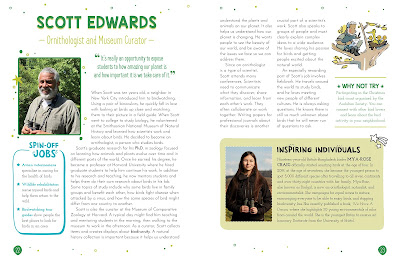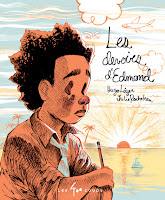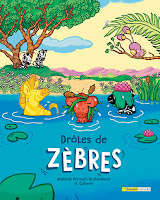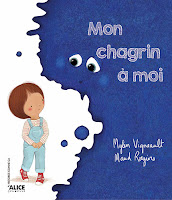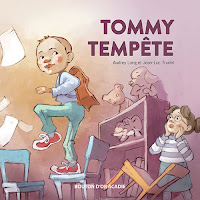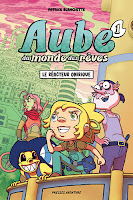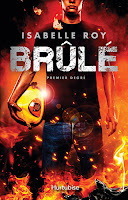Today is the release of Kathleen Gros's new graphic novel Anne: An Adaptation of Anne of Green Gables (Sort Of). Yesterday I reviewed this new book and today I am pleased to present this interview with author-illustrator Kathleen Gros.
Anne: An Adaptation of Anne of Green Gables (Sort Of)
Written and illustrated by Kathleen Gros
Quill Tree Books (HarperCollins)
978-0-06-305766-1
304 pp.
Ages 8-13
Released October 25, 2022
Helen Kubiw: As Anne: An Adaptation of Anne of Green Gables (Sort Of) is a modernized graphic novel of a Canadian classic, you would have had to make many decisions about which elements to keep and modernize (e. g., Gilbert pulling on Anne's braid) and which to eliminate? How did you make those decisions?
Kathleen Gros: Choosing what to keep and what to cut is the hardest part of making a graphic novel adaptation. Comics is a very different medium than prose. One page of a prose novel can turn into upwards of 5 pages of comics, depending on how the cartoonist handles it. So, of course, when looking at adapting a novel there’s a lot that has to be cut out.
The way I approach making a modernized adaptation is to start by making a lot of lists. I make lists of what I think the overarching themes for the story are, the themes of the relationships between characters, as well as the key scenes that stick in my memory after I close the book. Having a strong idea of what I feel the themes of the original narrative are helps guide me as I muddle my way through deciding which scenes to keep and transform, and which scenes to omit.
One of the big themes in the original work is the idea of a somewhat insular community. In the novel, that’s the rural town of Avonlea. I wanted to reflect on what community means to me in the 21st century. I’ve lived all of my adult life in apartments, which are their own unique kind of community, so it felt natural to turn the town of Avonlea into an apartment building! While some readers might wonder about this decision, I tried to give a few nods to L. M. Montgomery by using imagery from my own childhood in Toronto to inspire the setting of Anne. The original book is set in Prince Edward Island, but Montgomery actually spent a significant amount of her life in Ontario and Toronto!
One of my favourite parts of the original novel is when Anne starts a story club with her peers. I feel like this part of her story doesn’t get enough love! In my adaptation, I expanded this part of the narrative and gave it a bit of an update. My love of comics and creative writing was, in part, fostered by a teacher I had in high school who ran our school’s zine club (thank you Ms. Kim). Around the time that the original novel was written, people were really into the art of collage. Montgomery, herself, even kept collaged scrap books! Having Anne join a zine club felt like a way to give a wink to that history, while also incorporating my own connection to the original work. Anne’s storyteller side and creativity was something that really resonated with me as a kid.
HK: Though you've included all the key characters from the original Anne of Green Gables–Anne, Diana, Marilla, Matthew, Gilbert, Josie, Ruby, Mrs. Lynde–they are similar and yet different. For example, though Marilla was initially reluctant to take on Anne, unlike Matthew, she actually comes around far more quickly to supporting the girl in your book than originally. Why did you do this?
Kathleen Gros: This kind of comes down to the economy of storytelling necessary for a graphic novel. The original book spans years of Anne’s life, while my adaptation is translated into just a few months. My favourite parts of Marilla and Anne’s relationship come once Marilla has softened a bit. So I chose to kind of expedite the whole process in this new version.
HK: Some fans of the original story may not appreciate a retelling, sort of, in a contemporary setting and with similarly-named characters with different characterizations. How would you address their need to leave the original unaltered?
Kathleen Gros: I don’t think I’m ever going to manage to persuade a fan like that! And that’s okay. My feelings about adaptations is that they’re a way to continue a conversation about a work. To me, an adaptation is a way to examine the work, the cultural values around the work, the themes of the work, and find ways to respond to and reflect on those things. If that’s not how someone enjoys engaging with media, that’s okay. The original work still exists, and they can reread it forever. But I would say: I think you’ll have fun with my adaptation if you decide to give it a try.
HK: What was the toughest decision you had to make about your adaptation?
Kathleen Gros: The toughest decisions were all the stuff I had to cut out! I wish I had about 100 more pages to be able to fit in a chapter about Marilla’s amethyst brooch and the Raspberry Cordial Incident—but there just wasn’t space. I hope readers will forgive me for those omissions and enjoy the other elements I expanded on.
HK: You've changed a key relationship from friendship to a romantic one. Was this a key premise upon which you based your adaptation or is it something that evolved as you wrote the story?
Kathleen Gros: A big commonality shared by many of my friends who are queer women is that when they first read about Anne and Diana’s friendship, they felt their childhood crushes reflected back at them. Rereading the book as an adult, it’s so easy to see that connection. Anne and Diana profess their love for each other over and over again. They exchange locks of their hair. Anne is inconsolable when she accidentally imagines Diana marrying a man. I really wanted to honour the experiences of my friends with this adaptation. I think a couple of them would have been livid if I hadn’t approached the work through a queer lens. I’m joking, but I do want to acknowledge that it’s a huge privilege to get to queer classic works the way I have been able to. In classic literature, queer people mostly exist in subtext. There are people today (in both Canada and the US) who wish that they wouldn’t enter the text at all. It’s a very special thing to be entrusted with bringing that queerness into the actual text.
HK: Anne: An Adaptation of Anne of Green Gables (Sort Of) is your second retelling, having previously written Jo: An Adaptation of Little Women (Sort Of). Do you have any plans for reimagining other classic tales as contemporary graphic novels? (Please, please, please do Pride & Prejudice!)
Kathleen Gros: Ha ha I’m open to doing another contemporary retelling! Little Women and Anne of Green Gables are two books I absolutely adored growing up—and I want to make sure that if I do another retelling that it’s coming from a similar place of admiration and celebration. It would be nice to round out the (Sort Of) adaptations with a third book, don’t you think? Three books is always a satisfying number.
• • • • • • •
Many thanks to Kathleen Gros
for answering my probing questions
and to Shayla Leung, Publicist
at HarperCollins Canada, for facilitating this interview.
• • • • • • •

